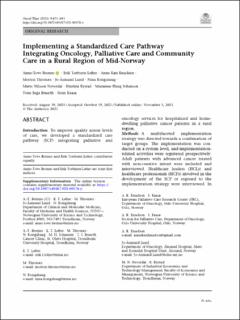| dc.contributor.author | Brenne, Anne-Tove | |
| dc.contributor.author | Løhre, Erik T | |
| dc.contributor.author | Knudsen, Anne Kari | |
| dc.contributor.author | Thronæs, Morten | |
| dc.contributor.author | Lund, Jo-Åsmund | |
| dc.contributor.author | Kongshaug, Nina | |
| dc.contributor.author | Neverdal, Marte Nilssen | |
| dc.contributor.author | Rystad, Kristina Edvardsen | |
| dc.contributor.author | Johansen, Marianne Haug | |
| dc.contributor.author | Braseth, Tone Inga | |
| dc.contributor.author | Kaasa, Stein | |
| dc.date.accessioned | 2022-03-04T10:07:59Z | |
| dc.date.available | 2022-03-04T10:07:59Z | |
| dc.date.created | 2021-11-25T09:40:49Z | |
| dc.date.issued | 2021 | |
| dc.identifier.citation | Oncology and Therapy. 2021, 9 (2), 671-693. | en_US |
| dc.identifier.issn | 2366-1070 | |
| dc.identifier.uri | https://hdl.handle.net/11250/2983061 | |
| dc.description.abstract | Introduction To improve quality across levels of care, we developed a standardized care pathway (SCP) integrating palliative and oncology services for hospitalized and home-dwelling palliative cancer patients in a rural region. Methods A multifaceted implementation strategy was directed towards a combination of target groups. The implementation was conducted on a system level, and implementation-related activities were registered prospectively. Adult patients with advanced cancer treated with non-curative intent were included and interviewed. Healthcare leaders (HCLs) and healthcare professionals (HCPs) involved in the development of the SCP or exposed to the implementation strategy were interviewed. In addition, HCLs and HCPs exposed to the implementation strategy answered standardized questionnaires. Hospital admissions were registered prospectively. Results To assess the use of the SCP, 129 cancer patients were included. Fifteen patients were interviewed about their experiences with the patient-held record (PHR). Sixty interviews were performed among 1320 HCPs exposed to the implementation strategy. Two hundred and eighty-seven HCPs reported on their training in and use of the SCP. Despite organizational cultural differences, developing an SCP integrating palliative and oncology services across levels of care was feasible. Both HCLs and HCPs reported improved quality of care in the wake of the implementation process. Two and a half years after the implementation was launched, 28% of the HCPs used the SCP and 41% had received training in its use. Patients reported limited use and benefit of the PHR. Conclusion An SCP may be a usable tool for integrating palliative and oncology services across care levels in a rural region. An extensive implementation process resulted in improvements of process outcomes, yet still limited use of the SCP in clinical practice. HCLs and HCPs reported improved quality of cancer care following the implementation process. Future research should address mandatory elements for usefulness and successful implementation of SCPs for palliative cancer patients. | en_US |
| dc.language.iso | eng | en_US |
| dc.publisher | Springer | en_US |
| dc.rights | Navngivelse-Ikkekommersiell 4.0 Internasjonal | * |
| dc.rights.uri | http://creativecommons.org/licenses/by-nc/4.0/deed.no | * |
| dc.title | Implementing a Standardized Care Pathway Integrating Oncology, Palliative Care and Community Care in a Rural Region of Mid-Norway | en_US |
| dc.type | Peer reviewed | en_US |
| dc.type | Journal article | en_US |
| dc.description.version | publishedVersion | en_US |
| dc.source.pagenumber | 671-693 | en_US |
| dc.source.volume | 9 | en_US |
| dc.source.journal | Oncology and Therapy | en_US |
| dc.source.issue | 2 | en_US |
| dc.identifier.doi | 10.1007/s40487-021-00176-y | |
| dc.identifier.cristin | 1958811 | |
| cristin.ispublished | true | |
| cristin.fulltext | original | |
| cristin.qualitycode | 1 | |

